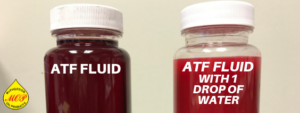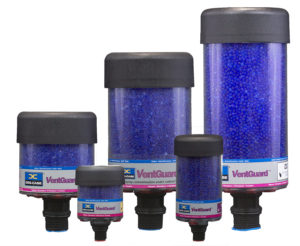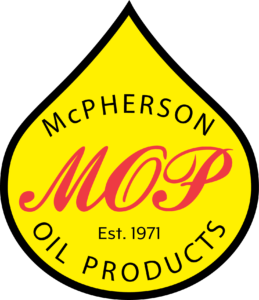
We know that bulk tank contamination can halt any quick lube, plant, fleet or mill in its steps. One tiny drop of water can turn a clear, transparent solution into an unusable liquid. Just look at the example. One drop of water turned this ATF solution to an opaque mess. That is why reservoir management is important to prevent tank contamination.
We have partnered with ILS to give you some tips and tricks on reservoir management to help prevent tank contamination.

- Install Breathers – Replacing the standard dust cap, desiccant breathers protect the contents of your storage tank from airborne moisture and particulate contamination. Each time equipment “breathes,” dirt, debris, and moisture are brought in, contaminating the lubricant and damaging the equipment over time. As air is drawn into the equipment through the breather, the layered filter elements remove particulates and harmful moisture. This can be used while the tank is in service or shut down. Desiccant breathers can be purchased directly from Des-Case or Donaldson.
- Tank inspection – An expert can inspect a tank for leaks or faulty gaskets in need of replacement or sealing. A different set of eyes may find the problem better than someone who has seen the tank day after day.
- HDPE Tank – While steel tote tanks are still a viable option, a fully customized HDPE tank may be a better solution. These tanks can have sample ports, a fill cap separate from a breather, a pump with filter, and more. These do not sweat as bad as metal tanks and do not rust or scale due to their material.
- Implement a kidney loop system for pumping into and out of tanks – Containing a motor, pump, and filter, these systems are ideal for removing solid particulates as well as soft particles, sludge, varnish and acid from reservoirs.
- Nest your lubricants and solutions in a lube room – A room or area in a facility where lubricants are stored, these areas can typically be climate controlled, self-contained and designed to plug and play. With certain controls in place, the lube room is a site where a company can create and reinforce a culture of effective, meticulous oil handing standards.
- Prevent oil and lubricant levels from getting low in the tank for an extended period of time. The extra air space that is created when the oil level is low can allow for additional moist air.
- Install drain plugs on the bottom of tanks to allow visual checks of water. In addition, avoid plastic screw-on caps on metal tanks. The difference in materials can allow different expansion and contraction in cold/hot weather allowing potential water seepage in screws. If it’s not possible to replace the caps, cover the caps or use a sealant to secure threads.
- For outdoor tanks at car dealerships /quick lubes, establish a procedure to visually check the oil before customers come in. The last thing you want is to fill a customer’s car with a contaminated lubricant.
- Establish a cleaning cycle at which the tank is drained and cleaned. In addition, be sure to flush tanks and lines between each non-compatible oil or fluid. Specialty companies, like our partners ILS, can clean the tanks using vacuum-driven procedures to ensure your tanks are clean of sludge and water deposits.
McPherson oil recommends flushing ATF tanks once a year. Our partners at ILS can handle everything from start to finish. The average cost is $600, not including any travel expenses. While this may seem a steep price, it’s far cheaper than the repercussions of a contaminated tank. We are happy to get you started on the path of clean tanks.
Together with McPherson Oil, ILS strives to achieve lubrication driven reliability through the many different services they provide. McPherson Oil and ILS consultants and technicians identify the root cause of lubrication related equipment failures and then work hand in hand with you and your team to implement the necessary procedures, processes or products to avoid their reoccurrence.
